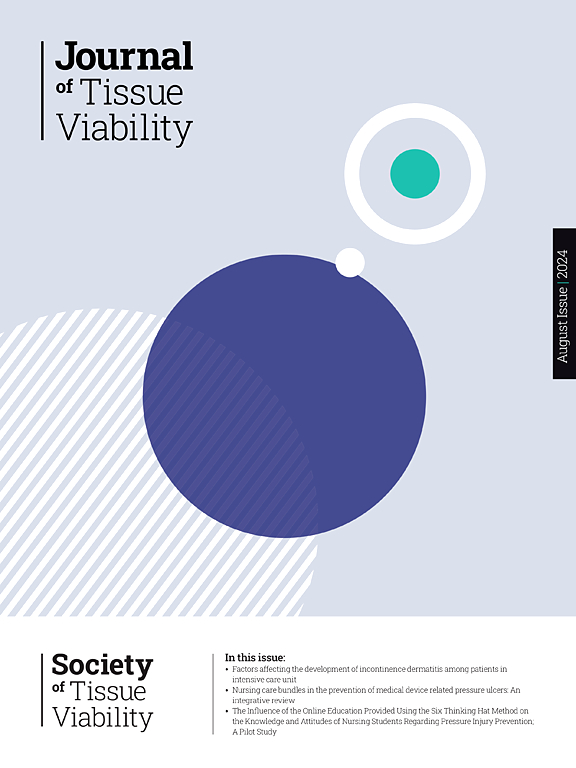How does the training given to intensive care nurses affect their attitudes toward preventing pressure ulcers?
IF 2.4
3区 医学
Q2 DERMATOLOGY
引用次数: 0
Abstract
Objective
The study aimed to determine the effect of training in the prevention/treatment of pressure ulcers on nurses' attitudes.
Material method
The study was conducted experimentally in a pretest-posttest design. Training was given to nurses participating in the study with content prepared by "Wound and Ostomy Incontinence Nurses Association" guide. The study was conducted between August and October with nurses working in Level 3 intensive care units. The study was completed with 79 nurses. Before the training was given, the "Nurse Introduction Form" and " Attitude Towards Pressure Ulcer Prevention Instrument (ATPUPI)" form were applied to those. All nurses were re-administered the ATPUPI scale three months after the training to evaluate their attitudes. Frequency analysis, descriptive statistics, one-way ANOVA, and independent sample tests were used in statistical analyses.
Results
The mean age of the nurses was 29.62 ± 5.74 years, the mean length of service was 71.77 ± 77.19 months, 94.9 % were graduates, and 82.3 % worked in shifts. The mean scores before the training were 44.53 ± 4.13 and 45.12 ± 2.53 after the training. It was determined that there was a significant difference between the nurses who did not receive training on pressure ulcers other than undergraduate education and those who obtained training in terms of the mean score of ATPUPI. Still, after the training, the mean scores reached a similar level, and this difference disappeared. The increase in the mean scores of those who did not receive any education other than undergraduate education was found to be statistically significant.
Conclusion
As a result of our study, intensive care nurses' attitudes toward preventing pressure ulcers were found to be at a high level. It was found that the training given to nurses who had not received training on pressure ulcers other than undergraduate education had a significant positive effect on their attitudes. According to this result, it is recommended that in-service training should be given from the moment they start intensive care and repeated at regular intervals to ensure continuity in knowledge, attitude, and care behavior.
对重症监护护士的培训如何影响她们对预防压疮的态度?
目的:本研究旨在确定预防/治疗压疮培训对护士态度的影响:研究旨在确定预防/治疗压疮培训对护士态度的影响:材料方法:本研究采用实验性的前测-后测设计。对参与研究的护士进行了培训,培训内容由 "伤口和造口失禁护士协会 "指南编写。研究于 8 月至 10 月间进行,对象是在三级重症监护病房工作的护士。共有 79 名护士完成了这项研究。在培训之前,对这些护士进行了 "护士介绍表 "和 "预防褥疮态度问卷(ATPUPI)"。培训结束三个月后,所有护士再次接受 ATPUPI 量表,以评估其态度。统计分析采用了频率分析、描述性统计、单因素方差分析和独立样本检验:护士的平均年龄为(29.62±5.74)岁,平均工龄为(71.77±77.19)个月,94.9%为毕业生,82.3%轮班工作。培训前的平均得分是(44.53 ± 4.13)分,培训后的平均得分是(45.12 ± 2.53)分。结果表明,除本科教育外未接受过压疮培训的护士与接受过培训的护士在 ATPUPI 平均得分上存在显著差异。但在培训后,平均得分达到了相似的水平,这种差异消失了。除本科教育外,未接受任何其他教育者的平均得分的提高在统计学上有显著意义:我们的研究结果表明,重症监护护士对预防压疮的态度处于较高水平。研究发现,对那些除本科教育外未接受过任何有关压疮培训的护士进行培训,对其态度有明显的积极影响。根据这一结果,建议从开始重症监护的那一刻起就进行在职培训,并定期重复培训,以确保知识、态度和护理行为的连续性。
本文章由计算机程序翻译,如有差异,请以英文原文为准。
求助全文
约1分钟内获得全文
求助全文
来源期刊

Journal of tissue viability
DERMATOLOGY-NURSING
CiteScore
3.80
自引率
16.00%
发文量
110
审稿时长
>12 weeks
期刊介绍:
The Journal of Tissue Viability is the official publication of the Tissue Viability Society and is a quarterly journal concerned with all aspects of the occurrence and treatment of wounds, ulcers and pressure sores including patient care, pain, nutrition, wound healing, research, prevention, mobility, social problems and management.
The Journal particularly encourages papers covering skin and skin wounds but will consider articles that discuss injury in any tissue. Articles that stress the multi-professional nature of tissue viability are especially welcome. We seek to encourage new authors as well as well-established contributors to the field - one aim of the journal is to enable all participants in tissue viability to share information with colleagues.
 求助内容:
求助内容: 应助结果提醒方式:
应助结果提醒方式:


